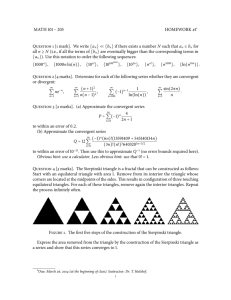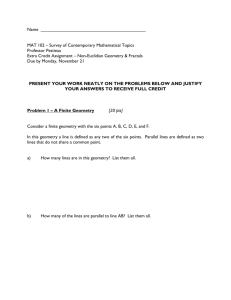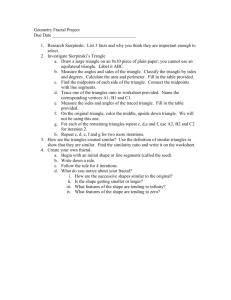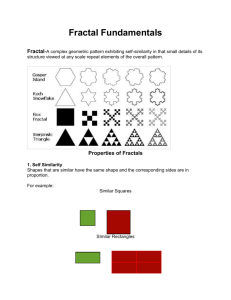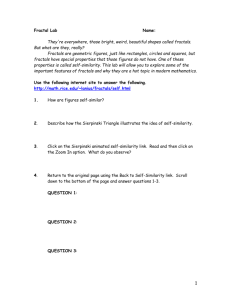Quantum Ising criticality on fractal lattices: Daniel Walsh
advertisement
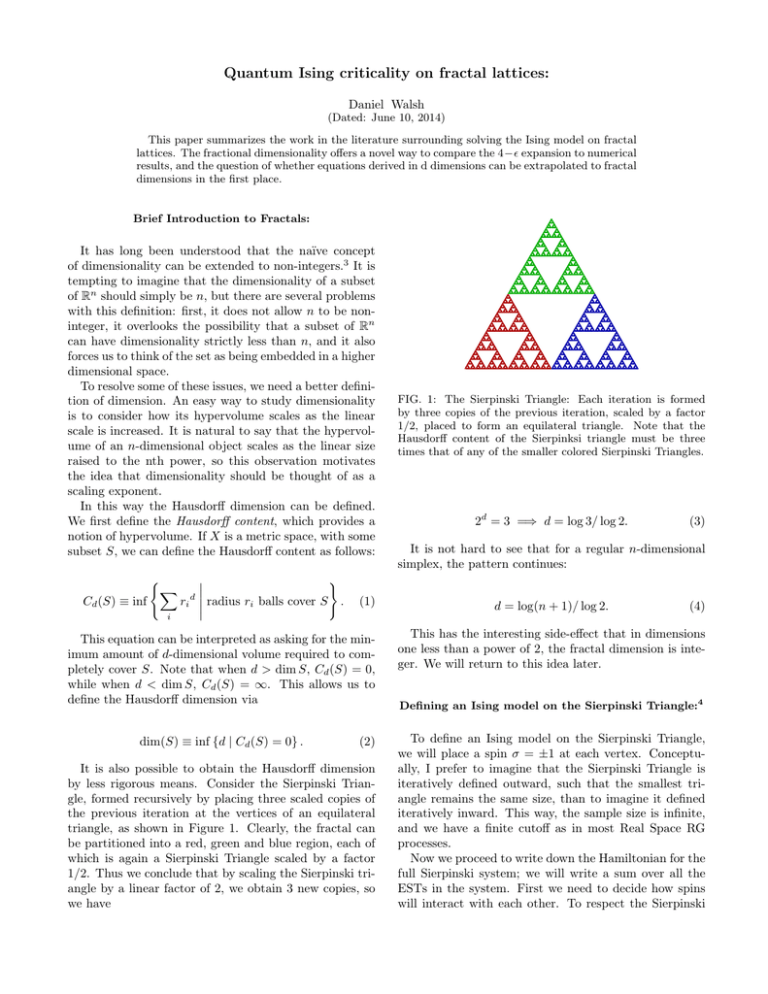
Quantum Ising criticality on fractal lattices:
Daniel Walsh
(Dated: June 10, 2014)
This paper summarizes the work in the literature surrounding solving the Ising model on fractal
lattices. The fractional dimensionality offers a novel way to compare the 4− expansion to numerical
results, and the question of whether equations derived in d dimensions can be extrapolated to fractal
dimensions in the first place.
Brief Introduction to Fractals:
It has long been understood that the naı̈ve concept
of dimensionality can be extended to non-integers.3 It is
tempting to imagine that the dimensionality of a subset
of Rn should simply be n, but there are several problems
with this definition: first, it does not allow n to be noninteger, it overlooks the possibility that a subset of Rn
can have dimensionality strictly less than n, and it also
forces us to think of the set as being embedded in a higher
dimensional space.
To resolve some of these issues, we need a better definition of dimension. An easy way to study dimensionality
is to consider how its hypervolume scales as the linear
scale is increased. It is natural to say that the hypervolume of an n-dimensional object scales as the linear size
raised to the nth power, so this observation motivates
the idea that dimensionality should be thought of as a
scaling exponent.
In this way the Hausdorff dimension can be defined.
We first define the Hausdorff content, which provides a
notion of hypervolume. If X is a metric space, with some
subset S, we can define the Hausdorff content as follows:
(
Cd (S) ≡ inf
X
i
ri
d
)
radius ri balls cover S .
(1)
FIG. 1: The Sierpinski Triangle: Each iteration is formed
by three copies of the previous iteration, scaled by a factor
1/2, placed to form an equilateral triangle. Note that the
Hausdorff content of the Sierpinksi triangle must be three
times that of any of the smaller colored Sierpinski Triangles.
2d = 3 =⇒ d = log 3/ log 2.
(3)
It is not hard to see that for a regular n-dimensional
simplex, the pattern continues:
d = log(n + 1)/ log 2.
(4)
This equation can be interpreted as asking for the minimum amount of d-dimensional volume required to completely cover S. Note that when d > dim S, Cd (S) = 0,
while when d < dim S, Cd (S) = ∞. This allows us to
define the Hausdorff dimension via
This has the interesting side-effect that in dimensions
one less than a power of 2, the fractal dimension is integer. We will return to this idea later.
dim(S) ≡ inf {d | Cd (S) = 0} .
To define an Ising model on the Sierpinski Triangle,
we will place a spin σ = ±1 at each vertex. Conceptually, I prefer to imagine that the Sierpinski Triangle is
iteratively defined outward, such that the smallest triangle remains the same size, than to imagine it defined
iteratively inward. This way, the sample size is infinite,
and we have a finite cutoff as in most Real Space RG
processes.
Now we proceed to write down the Hamiltonian for the
full Sierpinski system; we will write a sum over all the
ESTs in the system. First we need to decide how spins
will interact with each other. To respect the Sierpinski
(2)
It is also possible to obtain the Hausdorff dimension
by less rigorous means. Consider the Sierpinski Triangle, formed recursively by placing three scaled copies of
the previous iteration at the vertices of an equilateral
triangle, as shown in Figure 1. Clearly, the fractal can
be partitioned into a red, green and blue region, each of
which is again a Sierpinski Triangle scaled by a factor
1/2. Thus we conclude that by scaling the Sierpinski triangle by a linear factor of 2, we obtain 3 new copies, so
we have
Defining an Ising model on the Sierpinski Triangle:4
2
1
4
Hi [σ] = K(σ1 (σ4 + σ5 ) + σ2 (σ4 + σ6 )
|
{z
}
5
pairwise interactions via 1 and 2
2
6
+ (σ3 + σ4 )(σ5 + σ6 ) + σ5 σ6 )
{z
} | {z }
|
3
diamond 4536
B
+ (σ1 + σ2 + σ3 ) +
|2
{z
}
vertex magnetic field
5 and 6
B(σ1 + σ2 + σ3 )
|
{z
}
(7)
non-vertex magnetic field
+ K3 (σ1 σ4 σ5 + σ2 σ4 σ6 + σ3 σ5 σ6 ) .
|
{z
}
triple-interactions
FIG. 2: The Sierpinski setup: We consider the second iteration of the Sierpinski Triangle, made of a red, green, and
blue sub-unit. Each colored sub-unit we will call an elementary Sierpinski Triangle, or EST. We also use the spin index
convention from Luscombe et. al.4
Geometry, we will consider two spins to be neighbors if
and only if they are connected by an edge in the Sierpinski Triangle. In other words, sites that would be adjacent
in a triangular lattice are not considered adjacent here if
they span across a gap in the ST. Similarly, we also allow
for the possibility of a cubic spin term, with odd parity
under spin reversal:
X
exp H[σ 0 ] =
(5)
where the sense of hijki means that triangle ijk is a
smallest upward pointing triangle in the ST (such as 145
in figure 2). Again, we exclude downward pointing triangles from having this triple-interaction term because they
don’t respect the ST geometry. Consequently, we recognize that there are no terms that couple the ESTs! The
only way the ESTs talk to each other is through shared
points at their vertices (e.g. vertices 2 and 3 of figure 2).
For this reason, the Hamiltonian admits a “noninteracting representation”:
X
Hi [σ].
(6)
0
X
exp H[σ],
(8)
σ
where the σ is summed to respect σ 0 . After setting the
external field and the triple-interaction to zero, the recursion relation becomes4
e
σi σj σk ,
hijki
H[σ] =
Notice in the first magnetic field term, there is a factor
of 12 to prevent the magnetic field term on the vertices of
the ESTs from being double-counted by their neighbors.
Now we must sum over the spins {4, 5, 6}, and identify
the decimated system with the original one:
4K 0
4K
=e
1 − e−4K + 4e−8K
1 + 3e−4K
.
(9)
This recursion relation has a fixed point at k = 0 and
k = ∞, with no finite temperature phase transition. Because of the finite (3) ramification of the ST, perhaps
this has something to do with the lack of interesting
phase transitions, in much the same way that the 1D
Ising model does not have a finite temperature phase
transition (itself having ramification number 2).
Quantum Ising Model:1
We now turn to the Quantum Ising model on the Sierpinski Triangle, but this time we use a slight modification of the Sierpinski Lattice; the iteration step connects
three copies of the previous iteration via edges, rather
than merely identifying the vertices. This is a technical
simplification that does not change the geometric resemblance of the lattice to a ST.
i
Goals:
Our job is now to figure out how to write Hi [σ],
which can come from the standard nearest neighbor interactions, from the external magnetic field, and finally
through our strange triple-interaction:
The big question here is how seriously we should take
the notion of a fractal dimension, with regards to comparing with analytical work via -expansion. In other words,
in one sense the ST is a 2D lattice because it is a planar
3
graph, but on the other hand it is tempting to associate
log 3
its dimension with the fractal dimension of log
2 ≈ 1.585.
Let us take the second interpretation, and suppose that
the ST serves as a kind of extrapolation to dimension between 1 and 2. Unfortunately, there is few success in the
literature on fractal lattices that can be readily solved numerically that reveal critical phenomena.5 It appears that
this disappointment is due to the fact that many such
fractal lattices have finite ramification number, meaning
arbitrarily large chunks can be “cut-out” of the fractal
(rendering them disconnected with the rest) by only cutting finitely many edges. However, what is usually possible is that studying fractal lattices can signal existence
or non-existence of quantum criticality in higher dimensions. It is for this reason that Yoshida and Kubica call
fractal lattices a “probe” for higher dimensional physics.1
Quantum Sierpinski Triangle:
The Quantum Sierpinski Triangle has been studied in
a transverse magnetic field with the following Hamiltonian:1
H() = −(1 − )
X
(i,j)∈E
Zi Zj − X
Xj .
(10)
j∈V
This Hamiltonian allows us to linearly interpolate between the nearest-neighbor interactions and the effect of
the transverse field, and the sums run over edges and
vertices respectively. Via the Quantum-Classical Correspondence, the classically equivalent system is the “Trotterized” Sierpinski Triangle made from a stack of coupled
ST lattices. Then the problem can be solved via MonteCarlo methods.1 Yoshida and Kubica did this simulation
and found the following results with a few assumptions:
1. The Quantum system is at a fixed RG point
νd = 2 − α =⇒ d ≈
2 − 0.034
= 2.587.
0.76
(11)
Recalling that the dimension of the Trotterized version
of the Sierpinski Triangle is one larger than the dimension
of the standard ST, subtracting 1 from the result from
eq.(11), we obtain 1.587, which is an incredible 0.1% error.
Quantum Sierpinski Tetrahedron:1
Yoshida and Kubica also point out an interesting fact I
proved in eq. (4): the fractal dimension of the Sierpinski
Tetrahedron (STet), is exactly 2. It is a truth universally acknowledged that a universality class in possession
of a quantum phase transition must be determined fully
by its symmetry class and the dimensionality. Accordingly, this coincidence of a fractal and non-fractal dimension provides an intriguing way to test this claim. When
Yoshida and Kubica did the numerics on the STet, they
discovered the following critical exponents:
ν = 0.0660, γ = 1.5800,
(12)
Whereas the critical exponents for the 2D Quantum
Ising model are
ν = 0.06301, γ = 1.2372.
(13)
While ν is pretty close, γ (as well as other critical exponents), doesn’t do quite as well. This is evidence that
the universality class is not entirely determined by the
dimension and symmetry group of the lattice. For reasons I do not understand, this result may shed some light
on conformal bootstrapping.1
2. The correlation length diverges to the size of the
lattice L.
They were able to derive the following critical exponents via numerical methods which are beyond the scope
of this paper:
α = 0.034, ν = 0.76,
γ
β
= 0.237, = 2.111.
ν
ν
It is interesting to note that it is possible to solve for
the dimension of the system using the scaling relation
[1] B. Yoshida and A. Kubica, arXiv:1404.6311.
[2] F. Daerden and C. Vanderzande,
arXiv:condmat/9712183v1.
[3] Y. Gefen, B. B. Mandelbrot, and A. Aharony, Phys. Rev.
Lett. 45, 855 (1980).
[4] J. Luscombe, and R. C. Desai, Phys. Rev. Lett. 32, 1614–
1627 (1985).
[5] P. Tomczak, Phys. Rev. B 53, R500 (1996).
[6] A. Kubica and B. Yoshida, arXiv:1402.0619.
